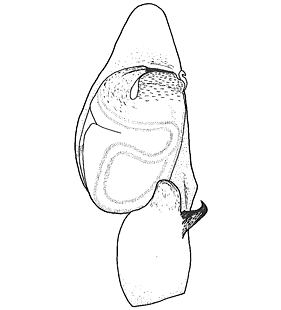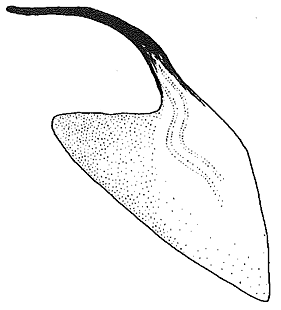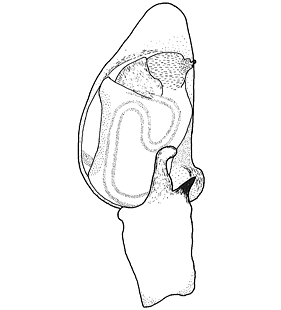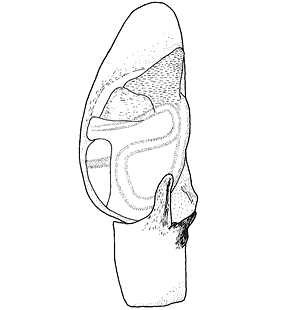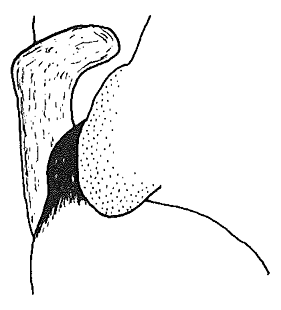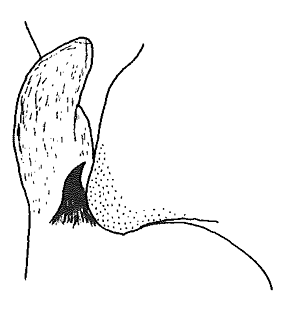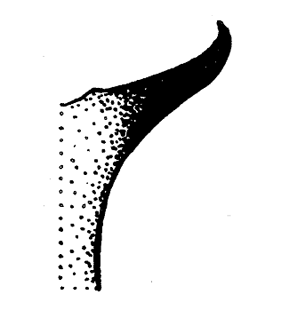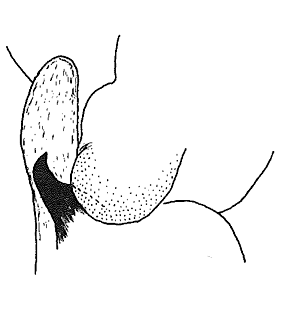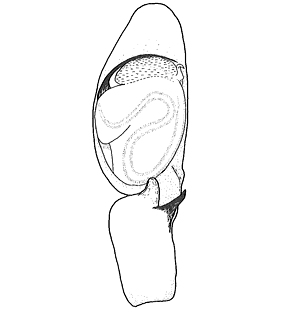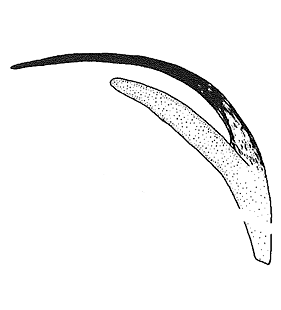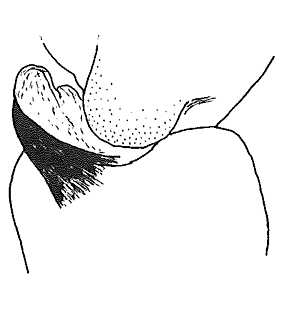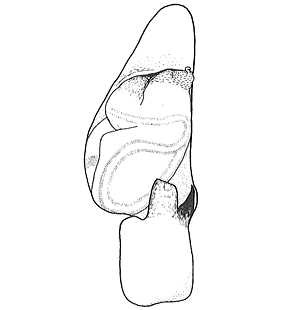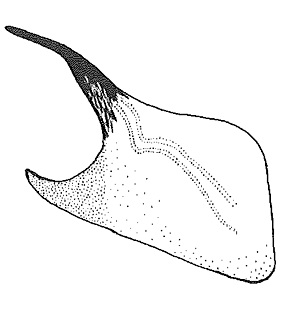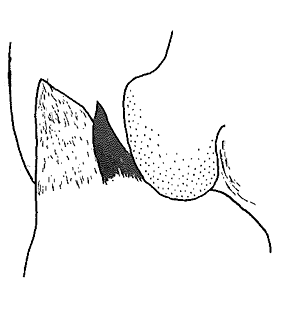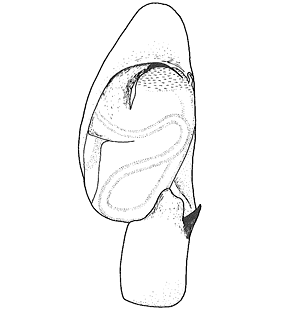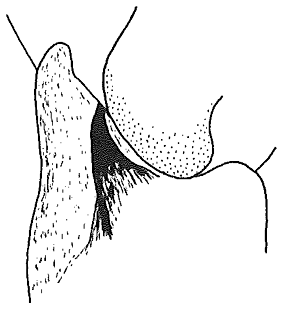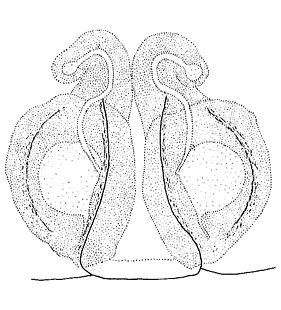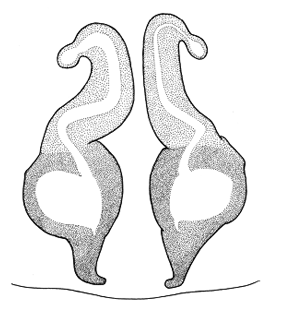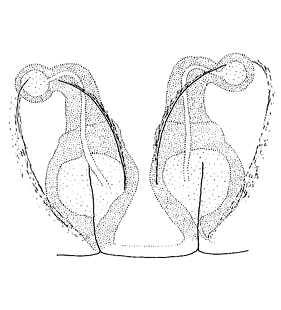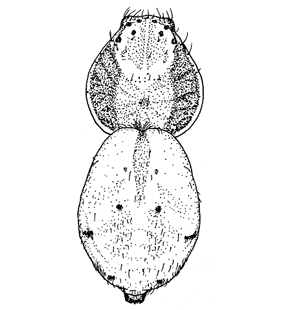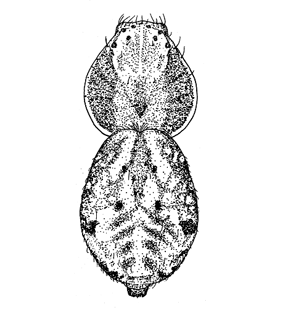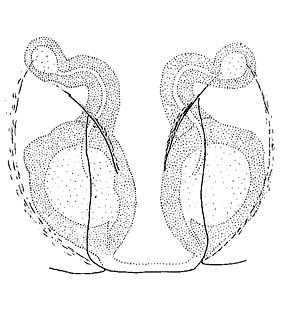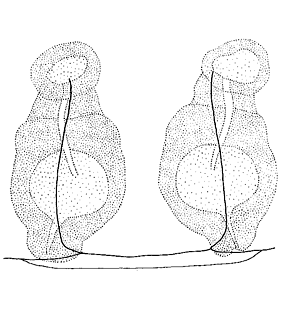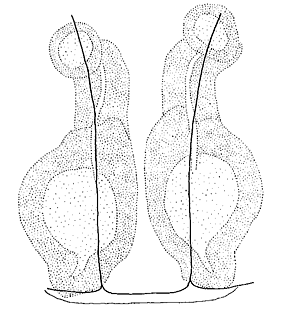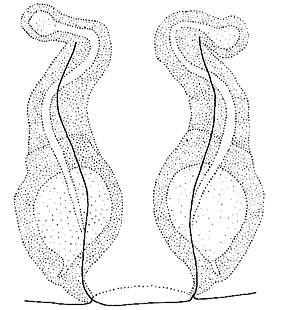Philodromus: pulchellus-Gruppe
|
Für Fehlermeldungen oder Verbesserungsvorschläge bitte Link folgen: click
|
||||||||
| 1 |
Männchen |
|||||||
| - | Weibchen |
|||||||
| 2 (1) |
Embolus in ventraler Ansicht verborgen, nur die äusserste Spitze manchmal sichtbar, Embolusbasis membranös ohne paraembolaren Vorsprung; Konduktor ohne oder mit kleinen fingerförmigen Fortsätzen |
| ||||||
| - | Embolus in ventraler Ansicht gut sichtbar, an seiner dorsalen Seite mit verborgenem paraembolarem Vorsprung, der die halbe Länge oder mehr des distalen Embolus ausmacht, die Spitze des Konduktors mit einem krallenartigen Fortsatz |
| ||||||
| 3 (2) |
Schleife des Einführgangs asymmetrisch, mit absteigendem Teil |
| ||||||
| - | Schleife des Einführgangs symmetrisch, ohne absteigendem Teil |
| ||||||
| 4 (3) |
Cymbium mit prolateral-basaler Ausbuchtung, Bulbus in schräger Position, Spitze der ventralen Tibialapophyse deutlich hakenförmig Pulchellodromus bistigma (Simon, 1870) |
| ||||||
| - | Cymbium schmal, Bulbus in gerader Position, Spitze der ventralen Tibialapophyse leicht retrolateral gebogen Pulchellodromus pulchellus (Lucas, 1846) |
| ||||||
| 5 (3) |
Konduktor lang, dreieckig Pulchellodromus medius (O. Pickard-Cambridge, 1872) |
| ||||||
| - | Konduktor kompakt, gestutzt mit kleiner retrolateralen Spitze Pulchellodromus ruficapillus (Simon, 1885) |
| ||||||
| 6 (2) |
Cymbium schmal mit mehr oder weniger parallelen Seitenrändern, Basis des Embolus schwach vergrössert Pulchellodromus punctiger (O. Pickard-Cambridge, 1908) |
| ||||||
| - | Cymbium breit, stark asymmetrisch; Tegulum mit prolateral-basaler Ausbeulung, Basis des Embolus deutlich angeschwollen |
|||||||
| 7 (6) |
Retrolaterale Tibialapophyse stark vorstehend, Winkel zwischen Tibialapophysen >60°; Spitze des paraembolaren Vorsprungs stumpf Pulchellodromus simoni (Mello-Leitão, 1929) |
| ||||||
| - | Retrolaterale Tibialapophyse aufrecht, Winkel zwischen Tibialapophysen <45° (Figs 18, 19); Spitze des paraembolaren Vorsprungs zugespitzt |
|||||||
| 8 (7) |
Abgeschnittener vorderer Rand der ventralen Tibialapophyse gerade; Embolus plötzlich spitz zulaufend, unregelmässig gekrümmt Pulchellodromus glaucinus (Simon, 1870) |
| ||||||
| - | Abgeschnittener vorderer Rand der ventralen Tibialapophyse konkav; Embolus gleichmässig spitz zulaufend, regelmässig gekrümmt Pulchellodromus pardalis (Muster & Bosmans, 2007) |
| ||||||
| 9 (1) |
Epigyne mit Seitengruben; medianes Septum erhaben |
| ||||||
| - | Epigyne ohne Seitengruben; medianes Septum leicht eingesenkt |
| ||||||
| 10 (9) |
Medianes Septum ohne Kiel; Drüsenköpfchen undeutlich Pulchellodromus bistigma (Simon, 1870) |
| ||||||
| - | Medianes Septum mit erhabenem Kiel; Drüsenköpfchen globulär |
|||||||
| 11 (10) |
Kiel des medianen Septums schmal; Einführgänge so lang wie Durchmesser der Rezeptakula Pulchellodromus medius (O. Pickard-Cambridge, 1872) |
| ||||||
| - | Kiel des medianen Septums breit, Einführgänge kürzer als Durchmesser der Rezeptakula |
|||||||
| 12 (11) |
Sklerotisierte Bögen des medianen Kiels auffällig, Einführgänge breit (1/2 Durchmesser der Rezeptakula), Drüsenwälle gross Pulchellodromus ruficapillus (Simon, 1885) |
| ||||||
| - | Sklerotisierte Bögen des medianen Kiels unauffällig; Einführgänge schmal (1/3 Durchmesser der Rezeptakula; Drüsenwälle klein Pulchellodromus pulchellus (Lucas, 1846) |
| ||||||
| 13 (9) |
Einführgänge kurz, Abstand der Drüsenköpfchen von den Rezeptakula weniger als ihr Durchmesser |
|||||||
| - | Einführgänge lang, Abstand der Drüsenköpfchen von den Rezeptakula mehr als ihr Durchmesser |
|||||||
| 14 (13) |
Einführgänge nach lateral gebogen; medianes Septum deutlich länger als breit Pulchellodromus glaucinus (Simon, 1870) |
| ||||||
| - | Einführgänge nach ventral gebogen, medianes Septum fast so breit wie lang Pulchellodromus simoni (Mello-Leitão, 1929) |
| ||||||
| 15 (13) |
Rezeptakula berühren sich fast über eine längere Strecke, medianes Septum deutlich schmal Pulchellodromus pardalis (Muster & Bosmans, 2007) |
| ||||||
| - | Rezeptakula deutlich voneinander getrennt, medianes Septum relativ breiter Pulchellodromus punctiger (O. Pickard-Cambridge, 1908) |
|

